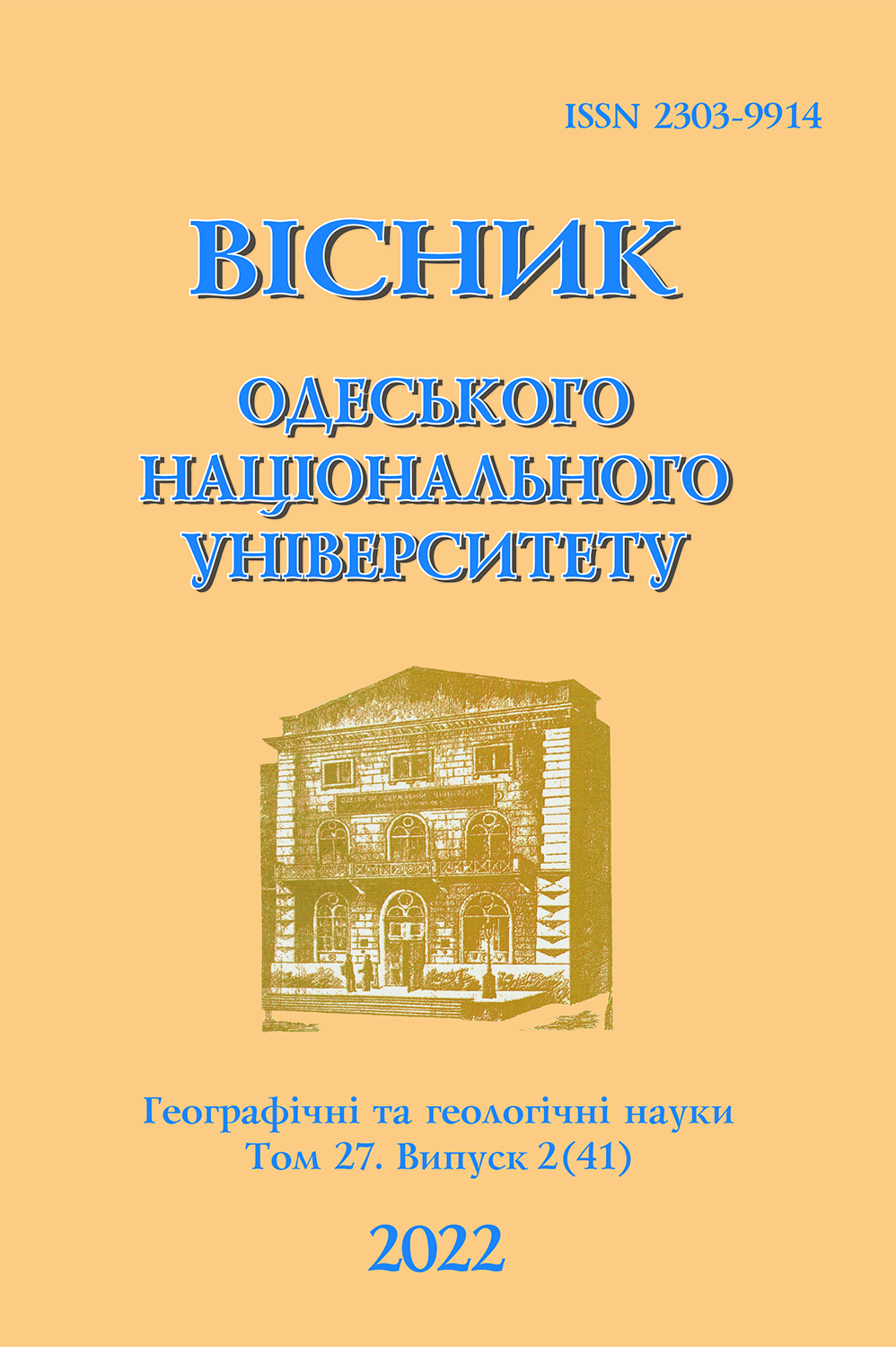ОСОБЛИВОСТІ ПЛАНУВАННЯ ТЕРИТОРІЙ ТА СИСТЕМ РОЗСЕЛЕННЯ: ВІД МИНУЛОГО ДО СУЧАСНОГО
DOI:
https://doi.org/10.18524/2303-9914.2022.2(41).268756Ключові слова:
територіальне планування, містобудування, торговельна діяльність, теорія концентричних зон, секторна модель, експлуатаційна модель, змішане скануванняАнотація
У статті розкрито особливості планування територій та систем розселення з допомогою діахронічного підходу до аналізу наукової літератури та наявних матеріалів. Розглянуто процес розселення античних міст, середньовіччя, етапів промислової та науково-технічної революцій, періоду розвитку сервісної економіки та сучасної постіндустріальної епохи. В аналізі виділені такі моделі планування територій та розвитку міст, як теорія концентричних зон, секторна модель, модель множинних ядер, експлуатаційна модель, підхід змішаного сканування та інші. Окремо наголошується важливість релігії та відповідних організацій у процесі планування територій. Враховуючи розглянуті підходи до планування територій та систем розселення, були виділені загальні особливості процесу. Певні висновки та пропозиції були представлені у відповідному розділі статті.
Посилання
Гнатченко Є. Ю. Економіка містобудування: конспект лекцій для студентів денної та заочної форм навчання освітнього рівня «магістр» за спеціальністю 192 – Будівництво та цивільна інженерія, освітня програма «Міське будівництво та господарство». Харків. нац. ун-т міськ. госп-ва ім. О. М. Бекетова. 2019. 86 с.
Радіонова Л. О. Соціологічні основи містобудування: курс лекцій для магістрів денної форми навчання спеціальності 191 – Архітектура та містобудування. Харків. нац. ун-т міськ. госп-ва ім. О. М. Бекетова., 2019. 134 с.
Стеблецька Ю. Ю. Моделі просторового розвитку міста. // Економічна та соціальна географія. 2014. № 2. С. 149–157.
Цебрій І. В., Назаренко Н. Духовне життя країн Західної Європи в епоху Середньовіччя та раннього Просвітництва: монографія. СтаробільськПолтава, ЛНУ, видавництво «Формат+», 2021. 206 с.
Bergmann L. William Wheeler Bunge: Radical Geographer (1928–2013). // Annals of the American Association of Geographers. 2018. № 108. С. 291–300.
Faludi A. The rationale of planning theory. – Oxford: Pergamon Press, 1973. 60 p.
Feingold D., Koop S. H. A., Van Leeuwen K. The city blueprint approach: Urban water management and governance in cities in the U.S. // Environmental Management. 2017. No61(7566). Springer Puplisher. pp. 9–23.
Glasmeier A. Territory-based regional development policy and planning in a learning economy: The case of ‘real service centers’ in industrial districts. // European Urban and Regional Studies. – 1999. № 6. С. 73–84.
Lane M. B. Public participation in planning: An intellectual history. // Australian Geographer. 2005. № 36.3. С. 283–299.
Loibl W., Etminan G., Gebetsroither-Geringer E., Neumann H.-M. and Sanchez-Guzman S. Characteristics of urban agglomerations in different continents: History, patterns, dynamics, drivers and trends. In (Ed.), Urban Agglomeration. IntechOpen. 2018. Religion and Urban Planning: Challenges and Possibilities // Berkley Forum. 2019. URL: https://berkleycenter.georgetown.edu/posts/religion-and-urban-planning-challenges-and-possibilities (дата звернення: 11.11.2022)
Schwirian, K. P. Ecological models of urban form: Сoncentric zone model, the sector model, and the multiple nuclei model. The Blackwell Encyclopedia of Sociology. 2007.
REFERENCES
Hnatchenko, Ye. Yu. (2019). Ekonomika mistobuduvannya: konspekt lektsiy dlia studentiv dennoyi ta zaochnoyi form navchannya osvitnyoho rivnya “mahistr” za spetsialnistyu 192 – Budivnytstvo ta tsyvilna inzheneriya, osvitnya programa “Miske budivnytstvo ta hospodarstvo”. (Economics of urban planning: a synopsis of lectures for fulltime and part-time students of the Master’s educational level, specialty 192 – Construction and civil engineering, educational program “Urban construction and economy”). Kharkiv: O. M. Beketov National University of Urban Economy. [in Ukrainian].
Radionova, L.O. (2019). Sotsiolohichni osnovy mistobuduvannya: kurs lektsiy dlia mahistriv dennoyi formy navchannya spetsialnosti 191 – Arhitektura ta mistobuduvannya. (Sociological foundations of urban planning: a course of lectures for full-time masters in the specialty 191 – Architecture and urban planning). Kharkiv: O. M. Beketov National University of Urban Economy. [in Ukrainian].
Stebletska, Yu. Yu. (2014). Modeli prostorovoho rozvytku mista. (Models of spatial development of the city). Ekonomichna ta Sotsialna Geografiya, 2, 149–157.
Tsebriy, I.V., Nazarenko, N. (2021). Dukhovne zhyttia krayin Zakhidnoyi Yevropy v epokhu Seredniovichchia ta rannioho Prosvitnytstva: monohrafiya. (Spiritual life of the countries of Western Europe during the Middle Ages and the early Enlightenment: a monograph). Poltava: Format+Bergmann, L. (2018). William Wheeler Bunge: Radical geographer (1928–2013). Annals of the American Association of Geographers, 108, 291–300. Faludi, A. (1973). The rationale of planning theory. Oxford: Pergamon Press.
Feingold, D. (2017). The city blueprint approach: Urban water management and governance in cities in the U. S. Environmental Management, 61(7566), 9–23.
Glasmeier, A. (1999). Territory-based regional development policy and planning in a learning economy: The case of ‘real service centers’ in industrial districts. European Urban and Regional Studies, 6, 73–84.
Lane, M.B. (2005). Public participation in planning: An intellectual history, Australian Geographer, 36.3, 283–299.
Loibl, W., Etminan, G., Gebetsroither-Geringer, E., Neumann, H.-M. & Sanchez-Guzman S. (2018).
Characteristics of urban agglomerations in different continents: History, patterns, dynamics, drivers and trends. In (Ed.), Urban Agglomeration. IntechOpen. Religion and Urban Planning: Challenges and Possibilities. (2019). Berkley Forum. URL: https://berkleycenter.georgetown.edu/posts/religion-and-urban-planning-challenges-and-possibilities
Schwirian, K.P. (2007). Ecological models of urban form: Сoncentric zone model, the sector model, and the multiple nuclei model. The Blackwell Encyclopedia of Sociology.
##submission.downloads##
Опубліковано
Як цитувати
Номер
Розділ
Ліцензія

Ця робота ліцензується відповідно до Creative Commons Attribution-NonCommercial 4.0 International License.
Авторські права охороняються Законом України “Про авторське право і суміжні права”.
Автор зобов’язаний подавати свої матеріали у вигляді, що відповідає вимогам відповідних стандартів з підготовки авторських оригіналів та правил, установлених редакцією.
У разі відмови автору в публікації його матеріалів він має право на одержання висновку щодо цього.
Редакційна колегія залишає за собою право на редакційні виправлення.
Гонорар за опубліковані роботи авторам не сплачується, друкований примірник не видається.
Правовласниками опублікованого матеріалу являються авторський колектив та засновник журналу на умовах, що визначаються видавничою угодою, що укладається між редакційною колегією та авторами публікацій. Ніяка частина опублікованого матеріалу не може бути відтворена без попереднього повідомлення та дозволу автора.
Публікація праць в Віснику здійснюється на некомерційній основі.
Усі права на матеріали, опубліковані в Журналі, захищені. Будь-яке використання матеріалів, опублікованих в Журналі повністю або частково, без дозволу Видавництва забороняється. Запити відносно усіх видів використання вказаних матеріалів повинні спрямовуватися у Видавництво.
Автор (співавтори) несуть усю відповідальність за науковий зміст, достовірність відомостей, використовуваних в статті, а також за збереження державної і комерційної таємниці.
Відхилені редколегією статті авторам не повертаються. Рецензент і члени редколегії журналу не мають права використовувати матеріали статті без письмового дозволу автора.


